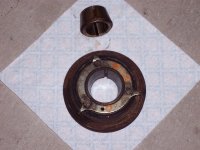The weather has been cold and wet here in south Louisiana for the last week, so I did not get much done.
On Saturday, Feb 18th, I started the car and put it up on ramps in preparation for verifying the timing as discussed above. It had sat for about 5 days. Temperature was about 38 degrees F and very damp. This day the white smoke was only on the right side, with black flecks depositing on the concrete behind the r/h exhaust. I did not see any smoke on the l/h side on that day or see similar flecks, although the flecks are all over the back of the tail lights and bumper on both sides, presumably from earlier test drives.
Up until now, the problem has been predominantly on the left side. The leaking injector was found on the l/h side.
Wednesday Feb 22, I started the car again out of curiosity, because the temperature was about 60 degrees F, although still very damp. Again the richness seemed to be on the right and not the left with the white smoke on that side and black flecks (unburned gas?) being deposited on the concrete on that side, but not any on the left.
In both instances the engine was cold and I did not continue running until up to normal temperature as I do during test drives. I don't understand what would make the problem change sides like that. O2 sensors?
I will post after pulling the O2 sensors to clean them with Carburator cleaner and after verifying the timing by removing the 1A plug. I hope to have that done in a few days.
In reading up about the Power Resistor, it divides the injectors into three groups of four. Any thoughts on how to rule it out? I swapped it with a used one that I had with no observed change.
Having swapped the Fuel ECU, replaced the coolant temp sensor, power resistor, repaired several wires, replaced the O2 sensors, repaired a vacuum leak for the MAP sensor, what else is there?
There is the air temp sensor left, but how do you test it?
There has to be something that I have overlooked.
One question that I have is that I had to replace the full throttle switch which I cracked when the engine was out. I traced around the base of the switch before replacing it so that I would install the new switch in the same position. How do you check to see that it opens/closes at the correct throttle opening? I don't find any discussion of that in the manual.
The Throttle potentiometer has the correct volt reading and appears to change smoothly throughout the range of travel.
How do you check the blue vacuum swith wired in parallel with it?

 Hi Guest!
Hi Guest!

 smilie in place of the real @
smilie in place of the real @
 Pretty Please - add it to our Events forum(s) and add to the calendar! >>
Pretty Please - add it to our Events forum(s) and add to the calendar! >> 

